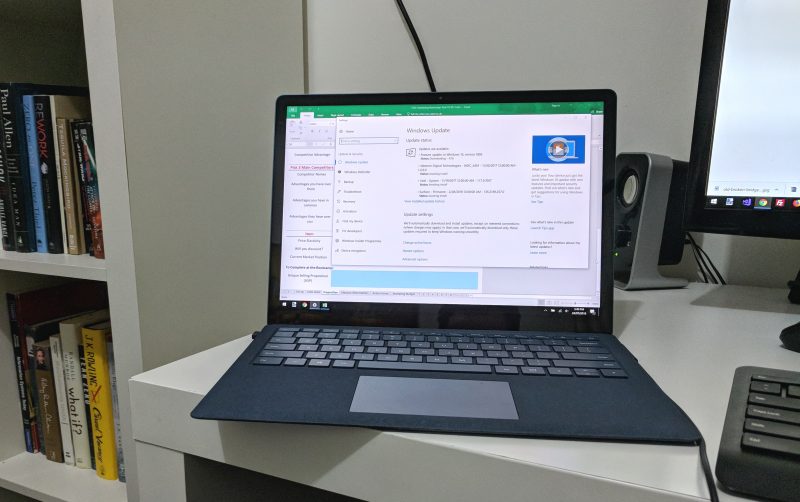I purchased a Microsoft Surface Laptop about six months ago (this post has been sitting in drafts for a while—sorry), after my trusty 2012 model Macbook Air started having age-related issues. It wasn’t a rejection of Apple; just a change to something new.
The base model Surface Laptop retails (at the time) for around AUD$1500 and would have been perfect for my needs. The only software I need to run is a web browser and occasionally Paint.NET, so a high-end laptop would be a frivolous waste of money.
Unfortunately, they don’t make the base model Surface Laptop in the blue colour that I wanted (which is complete bullshit), so I had no choice but to get the $500 more expensive mid-range Surface Laptop instead. I’m… not the smartest consumer in the world.

Setup & Configuration
Setting up the device for the first time was a little bit clunky. It went a lot smoother than any previous Windows device setup I’ve attempted, but the process is nowhere near as polished as competing operating systems.
The first hiccup was not being able to type in the email address for my Microsoft account, because the ‘@’ key wasn’t working. I was confused for a couple of seconds, before realizing that the keyboard had defaulted to the wrong layout (British instead of US). The button to change the input settings is conveniently placed on the login screen, so it wasn’t too big of a deal. Still—it would have been nice if the laptop was pre-configured for the region in which it was sold.
The next annoyance was Cortana. Microsoft’s not-especially-helpful digital assistant insists on narrating the whole setup process. Worse still, voice controls are used by default to configure certain options. I speak with a cultivated Australian accent, with a soupçon of mid-Atlantic influence (from watching too much Frasier), which Cortana finds challenging to parse. The whole process was much slower and more painful than just typing in information. Thankfully, Microsoft has since disabled Cortana during setup.
Windows setup detected that my Microsoft account had an active Office 365 subscription and offered to install the Office applications. I mention this because it was the only part of the setup that made me think ‘oh, that’s helpful‘.
At this point the Surface Laptop is setup and ready to use. Next came the several gigabytes of Windows updates that needed to be installed. That would be fine if Microsoft Update didn’t also decide that I needed to download and install a bunch of games, such as Minecraft and Candy Crush. I had hoped buying a Microsoft-made device would avoid bloatware, but I guess not.
Now we get to the most annoying part of the setup process. Even though the laptop had a Windows 10 Pro sticker on the box, the machine actually ships with Windows 10 S, which can only run apps from the Windows Store. Upgrading to Pro is free and (supposedly) straightforward, but it’s more wasted time and bandwidth. Unfortunately it wasn’t a simple upgrade to Windows Pro, because Microsoft Update got stuck installing some driver and wouldn’t continue with any new updates. Imagine my frustration to be one hour into owning a laptop and already be Googling inscrutable error messages and fucking around in the registry.
Using the Windows Laptop
The Windows Laptop is very pleasant to use. Aesthetically, it’s arguably the nicest laptop on the market. It’s thin, lightweight, and the Alcantara fabric makes it feel wonderful. As soon as people notice that it’s coated in fabric, they’re compelled to stroke it for a few seconds make a titillated ‘mmmm… sound. It’s weird, but it’s understandable. The fabric does get dirty, but it’s easy to clean.
The retina screen is stunning. Not having used a retina display before, I was surprised to find that most of the web looks horrible in high definition. Image resizing and compression does wonders for page loading speed, but produces images that look pixelated on retina screens. The solution is to serve different images to different devices depending on the pixel density they support, but it can be a huge pain in the ass and many websites simply haven’t bothered yet.
The display is also a touchscreen. I’m yet to find any compelling reason why a laptop needs to have a touch screen (especially if that screen isn’t detachable), but the Surface Laptop has one nevertheless. It’s come in handy at work a few times when someone else has dominion over the mouse and/or trackpad, and I need to click or dismiss something on the screen.
Performance-wise, the Surface Laptop can handle everything I throw at it—which admittedly isn’t very much. I don’t play any games, nor do I use any heavy video/graphics editing software, so it’s not exactly being pushed to the limit. It feels very snappy though: It always boots up in under ten seconds, I rarely hear the fans spinning, and it handled the notoriously RAM-hungry Google Chrome with 30 open tabs flawlessly.
The battery is also very good. I’ll always get at least 12 hours of use between charges, so there’s no risk of it dying midway through a workday if I forget to pack the charger. Speaking of the charger, it has one of those fantastic MagSafe plugs like the older Macbooks. Honestly, every device should be forced to use MagSafe by law.
Issues & Flaws
There’s two persistent and very frustrating issues with the Surface Laptop. The first is the WiFi connectivity. For some reason, it can’t handle switching between two WiFi networks. When I take the laptop from home to work, it’ll detect that the network has changed and automatically reconnect to the work network. The internet will then be unbearably slow and prone to dropping out, at least until the WiFi is turned off and then on again, after which it’ll work normally.
The second issue is even more frustrating. From time to time, the Surface Laptop doesn’t wake up. I’ll shut the lid, carry it down the hallway, lift the lid, and then be presented with a non-responsive black screen. Oddly, when this happens (which isn’t all the time) the keyboard will be completely illuminated on full brightness. When this happens, nothing will wake it up again—I just have to hold the power button down for 10 seconds and wait for it to reboot.
Closing Thoughts
The Surface Laptop has a lot of issues. I can totally understand someone reading this and deciding to stick with their ‘it just works!’ Apple products, but I still really love this laptop. It’s well built (all of the issues are software-related), it performs great, it’s reasonably priced, and it truly looks and feels fantastic.
